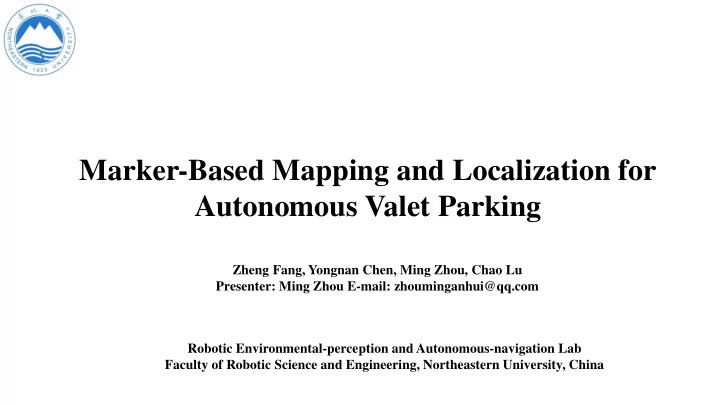

Marker-Based Mapping and Localization for Autonomous Valet Parking Zheng Fang, Yongnan Chen, Ming Zhou, Chao Lu Presenter: Ming Zhou E-mail: zhouminganhui@qq.com Robotic Environmental-perception and Autonomous-navigation Lab Faculty of Robotic Science and Engineering, Northeastern University, China
Contents 01 Background 05 Experiment 02 Related Work 03 Mapping 06 Conclusion 04 Localization 2
What is AVP? Traditional valet parking Auto valet parking 3
Benefits & Challenges • Driver-friendly • Enable high density parking • No GPS signals available • (1.6 million parking spaces for 4.37 • Vehicle movements will change the million vehicles in Beijing for 2014 ) appearance of the same place • Reduce accidents caused by human • Illumination condition is complicated in errors during parking such scenes • (40% Accidents occur during parking related maneuvers) 4
Related Works • Geometric SLAM Methods • Semantic SLAM Methods Geometric VSLAM Methods ORB_SLAM2 Detect ground ( IEEE Transaction on parking slots Robotics 2017 ) (IV 2018) VINS MONO AVP-SLAM ( IEEE Transaction on (IROS 2020) Robotics 2018 ) • Resource-demanding • Ground information may suffer from • Feature-based maps lack long-time stability occlusion or wearing 5
Algorithm Pipeline 6
Mapping Algorithms 7
Mapping Algorithms • Scale Recovery From Visual Fiducial Markers 1.Get the side length of the printed markers 2.According to the hypothetical 3D marker coordinate, get the corresponding corner point coordinate. 3.Extract markers from monocular image 4.Solve the PnP problem to get the relative pose of marker 5.Given the poses of the same marker in two images, we can recover the scale of monocular slam 8
Mapping Algorithms • Pose Optimization with Vehicle Odometry Constraints 1. Fuse wheel speed and steering angle to form vehicle odometry y 2. Add the vehicle odometry constraint edge to pose optimization l v L L L r : landmarks L P P x O K : keyframe pose : reprojection error K K K : vehicle odometry constraint 9
Localization Algorithms • Structure • Initialization • Data Association(Using Marker ID) • Coordinate Transform • Distribute Particles 2 𝑂 𝑦 0 , 𝑡𝑢𝑒 𝑦 𝑦 𝑜 2 𝑧 𝑜 𝑂 𝑧 0 , 𝑡𝑢𝑒 𝑧 = 𝜄 𝑜 2 𝑂 𝜄 0 , 𝑡𝑢𝑒 𝜄 10
Localization Algorithms • Motion Update • Observation Update 𝒒 𝒀 𝒖 |𝒜 𝒖 , 𝒗 𝒖 , 𝒀 𝒖 , 𝒏 = 𝒒 𝒀 𝒖 |𝒜 𝒖 , 𝒏, 𝒀 𝒖 𝒒 𝒀 𝒖 |𝒜 𝒖 , 𝒗 𝒖 , 𝒀 𝒖−𝟐 , 𝒏 = 𝒒 𝒀 𝒖 |𝒗 𝒖 , 𝒀 𝒖−𝟐 • Marker Filtering • Data Association & Coordinate Transform 11
Localization Algorithms • Observation Update • Visualization • Update Particle Weights • Resampling • No resampling while stationary • Output Vehicle Pose • Get average particle state rather than highest weighted 12
Experiments • Mapping Metric Evaluation Environment: ⚫ Underground garage about 500 𝑛 2 ⚫ Marker size is 0.552m ⚫ Average interval between markers is 8m ⚫ Total trajectory length is 143m Results: RMSE is 0.438m NESS is 0.306% 13
Experiments • Localization Accuracy Evaluation Error(m) Mean Max Min Std Median RMSE Experiment 1 0.301586 0.775068 0.015272 0.171292 0.259017 0.346836 Experiment 2 0.263982 0.686745 0.024782 0.157513 0.225755 0.307403 14
Experiments • Computational Resources • System Robustness • False matches due to environment appearance changes • Marker detections not affected 15
Conclusions • Pros • Long-term usable map & High environmental robustness • Low computational resource consumption • Cons • Limited scene of application 16
THANK YOU
Recommend
More recommend